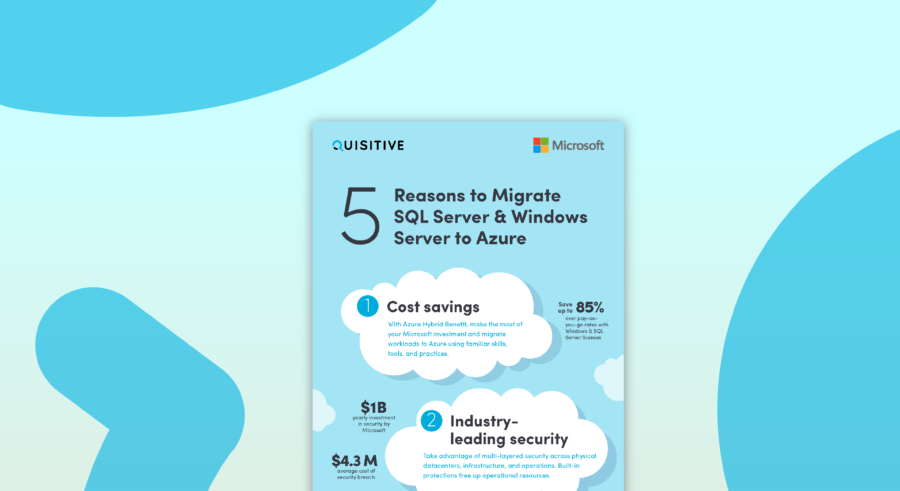In this article, I will share 3 things you can expect to get out of an Azure cloud readiness assessment with Quisitive. But first, I want to talk about why many organizations undergo an assessment and migration to the cloud.
To successfully fly a plane to the island of Fiji, you need to fully assess the journey before you take off from the airport. If your aircraft isn’t capable of flying the required range, you need to plan to stop for fuel along your chosen route, and triple check the accuracy of your navigational instruments. Once you’re over the ocean, your options are limited. Cloud migration holds its own perils for the unprepared. However, an informed migration can be a game-changer.
For those with aging hardware, burdensome maintenance, or a need to stay competitive, migration to the Azure cloud offers significant advantages. Benefits include inherent security and options for specific compliance, abundant native services for application modernization and process monitoring, and for many, an appreciable reduction in operating costs over the current costs on-premises. Migration to a cloud platform is the pivotal step in digital transformation.
But like flying to Fiji, it’s an equally risk-laden journey If you do it alone. Consequently, it’s logical to get guidance from experts who have traveled that route, navigated the vectors, and safely guided others to that digital haven hundreds of times.
That’s where my team comes in. We work with organizations of all sizes to conduct Azure cloud readiness assessments funded by Microsoft. Depending on your requirements, we might examine your infrastructure, redesign a set of applications, or show you how to consolidate your VDI onto multi-session platforms. We analyze your IT usage patterns, and the anomalies, to develop a route-specific to your Microsoft Azure migration. In our assessment deliverable, we include the risks and the expected future costs for operating in the cloud. Understanding these key points is an important first leg in your critical journey.
To prep you for the trip, here are 3 things you can expect from your Azure cloud readiness assessment.
1. Your assets are underutilized.
When you see the actual resource consumption of your Windows, Linux, and SQL servers, you realize how little they operate at or near capacity. Whether it’s CPU, memory, or database storage, it’s very common to overprovision on-premises. An Azure Foundation Engagement funded by Microsoft will enable us to provide you this detailed view of your estate and give specific recommendations based on this analysis.
When you’re buying physical hardware for your on-prem solutions, you need to plan for peak usage, but you can’t fully predict what that peak will be. Adding capacity later to seize an opportunity isn’t easy or quick. It requires requisitions, bidding, discussions with procurement, add in the time to ship, deliver and install that equipment, and by then, that opportunity might’ve gone to your competitor.
Other on-prem costs for rack space, power consumption, data connectivity, technical support, and physical security are significant components of the budget. When physical products reach their end of support, you have to pay for security updates or run the risk of security breaches. And the minute that new hardware comes online, it’s already being surpassed in the marketplace by something faster, more capable, and with lower costs.
But none of this gives you the scalability and flexibility that your company needs, the market demands, and the Azure cloud offers. Spin up and spin down resources when needed, scale as the usage spike rises, divert that viral traffic to other sources to satisfy your clients now. In the Azure cloud, you pay for what you use, not what you think you may need.
2. Your team needs to participate.
An Azure cloud readiness assessment is a dual team process. You’ll make a commitment of about 8 hours over the weeks, so we can understand your goals as a business, the talents you have, and the talents you want to hone. Whether you have an expensive co-lo lease coming due, racks full of technical debt, or plan to modernize your environment with PaaS platforms to stay competitive, the output of your assessment depends on you.
During your assessment, we facilitate that discussion and help you envision the possibilities of your future state. We consider your goals from a holistic point of view: your business goals, technical goals, financial goals, and strategic goals — all to inform your specific route to the Azure cloud.
If your goal is to modernize an application using PaaS options, the Application Innovation Engagement is a Microsoft funded vehicle we use to identify the app services you need to employ, design the architecture, and give you a view of your operating costs in the cloud.
Even if you’re not sure where to begin, we are. While your goals are unique, we’ve worked with hundreds of clients to navigate this same journey. We can run tools to provide specific information or simply talk to the team that lives with the issues. We need your participation, but we do the work. We analyze your environment and tailor an approach to ensure your objectives are at the center of every recommendation.
3. You will receive a validated deliverable.
When you fly to Fiji, it’s wise to file a flight plan with Flight Services so they know what to expect during your journey. They want to know your route, your cruising altitude, your planned arrival time, and if you choose to go home, when you’ll return. Surprises aren’t always welcome.
Similarly, before we finalize our recommendations for your environment, we want you to know where we’re headed. In working sessions with your team, we review our initial analysis to confirm or deny any assumptions, examine the performance outliers, and discuss service options with your team. For example, the data might suggest that we focus on file storage or disaster recovery, but for this engagement, those issues might not be a priority.
Once we get your feedback, we modify the output according to your requirements and begin to calculate your expected costs. If you own Software Assurance, there are significant cost advantages to bringing your own license to the cloud, especially when it comes to MS SQL. We’ll give you multiple cost options, from street pricing to reserved instances for your compute. Reserved instances offer deep discounts on the compute component if you’ll consider a 1 or 3-year commitment on capacity. From our experience, we know most companies keep their capital equipment much longer than 3 years.
While you may never fly a plane to Fiji, your cloud migration journey has risks worthy of preparation before you embark. A Microsoft-funded Azure cloud readiness assessment will help you understand the risks, but more importantly, will help you discover the strategic and competitive advantages to operating on a scalable modern platform.
Learn more about the Azure Cloud Readiness Assessment program here.

;)


